Introduction
For a comparatively small nation, Scotland contributed greatly to new place names around the English-speaking world. In one country after another where British settlers put down permanent roots, Scottish names can be found in abundance. For instance, there are at least 550 towns, suburbs, villages, mountains, rivers and other topographical features in South Africa alone that have Scottish names, as do more than 200 localities in the New York Metropolitan area.
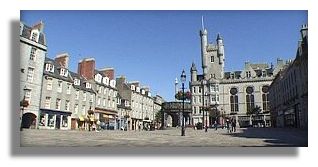
To take Aberdeen as an example, places with this name can be found in no less than 34 locations around the world, including three Australian states, as well as in Canada (Saskatchewan), Jamaica, Antigua, Guyana, South Africa (Eastern Province) and Sierra Leone. And there are 18 Aberdeens in the USA (including Arkansas, California, Idaho, Kentucky, Maryland, Mississippi, Missouri, New Jersey, North Carolina, Ohio, Pennsylvania, South Dakota, Texas, Washington). Perhaps the most famous example, known to seasoned travellers, is the picturesque but far from Scottish-looking settlement in Hong Kong. And the citizens of Boston, Massachusetts will know that Aberdeen is the name of one of their neighbourhoods and that part of it contains a cluster of roads with exclusively Scottish names (Ayr, Braemore, Colliston, Kilsyth, Kinross, Lanark, Orkney, Selkirk, Strathmore and Sutherland). A book has even been written about places around the world called Aberdeen.
Waves of Scottish settlers over a period of more than 400 years took not only their distinctive culture but also their names with them. The first among these were men and women who left Scotland during the seventeenth century for the West Indies and the southern colonies in America, both as free settlers and as political prisoners transported there by Oliver Cromwell. A second major wave were the Scots-Irish, i.e., ethnic Scots from Northern Ireland, who sailed in large numbers to New England, New York, Pennsylvania and the Carolinas during the early 1700s and whose hardy descendants effectively opened up the interior of what was to become the USA. Among the loyalists who left the USA after the American War of Independence were many Scotsmen, who took their names to Canada.
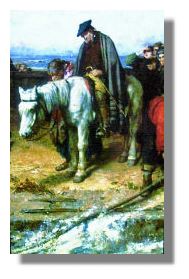 Large-scale Scottish migration, mainly for economic reasons, including the forced clearances of the Highlands, made the Scots a highly visible element in countries such as Canada and New Zealand. The profits to be made from animal furs brought many Scotsmen and Scottish place names to the Canadian territories west of Ontario, particularly through the Hudson's Bay Company. Moreover, the lure of gold during the nineteenth century also resulted in concentrations of Scottish place names in California, Yukon, Victoria, New South Wales and the Transvaal. And, of course, the Scots, along with the English, Irish and Welsh, flocked to the colonies and dominions in large numbers during times of economic recession at home.
Large-scale Scottish migration, mainly for economic reasons, including the forced clearances of the Highlands, made the Scots a highly visible element in countries such as Canada and New Zealand. The profits to be made from animal furs brought many Scotsmen and Scottish place names to the Canadian territories west of Ontario, particularly through the Hudson's Bay Company. Moreover, the lure of gold during the nineteenth century also resulted in concentrations of Scottish place names in California, Yukon, Victoria, New South Wales and the Transvaal. And, of course, the Scots, along with the English, Irish and Welsh, flocked to the colonies and dominions in large numbers during times of economic recession at home.
Well-known examples of places abroad that were given Scottish names include several major cities: Houston, Dallas, Knoxville, Albany, Calgary, Hamilton, Brisbane, Perth, Dunedin and Blantyre. Then there is Nova Scotia in Canada and the French territory of New Caledonia near Australia, the Murray river in Australia, the Mackenzie Mountains, River and Bay in Canada, and the Falkland Islands, South Shetland Islands and South Orkney Islands in the South Atlantic. But these are only the tip of the iceberg, a fact that becomes immediately apparent when studying detailed maps of provinces, counties and cities across the English-speaking world.
Toponymists generally agree that a major source of new names for places (second only to names that are purely descriptive of the terrain) is the honouring of an individual. In pioneer societies, such individuals might be explorers and missionaries, farmers and businessmen, mayors and aldermen. Royalty and nobility were also frequently honoured in colonial place names, often for places they never got to see! Military generals, governors, premiers and colonial secretaries provided another rich source of place names in the colonies. And, of course, homesick pioneers frequently named their new settlements after towns and villages, mountains and rivers in the Old Country. Scottish examples of all these sources of names can be found throughout the former colonies.
Prevalence
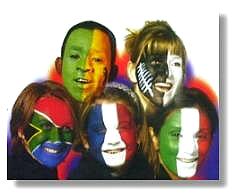 Across the USA, Canada, the Caribbean, Australia, New Zealand, South Africa and Zimbabwe, Scottish place names are found roughly in the ratio of one Scottish name to every four of English origin. Moreover, with a few notable exceptions, Scottish names appear to outnumber Irish ones by five to one, and Welsh ones by ten to one.
Across the USA, Canada, the Caribbean, Australia, New Zealand, South Africa and Zimbabwe, Scottish place names are found roughly in the ratio of one Scottish name to every four of English origin. Moreover, with a few notable exceptions, Scottish names appear to outnumber Irish ones by five to one, and Welsh ones by ten to one.
There are large regional variations, of course. Very few Scottish place names are to be found in New England, especially Connecticut and Massachusetts where English and indigenous names dominate the map. The proportion of names that are Scottish also decreases in south-western USA, where Spanish names are numerous and in Quebec Province, where place names are overwhelmingly French. The proportion also drops in South Africa (where names of indigenous Khoisan, Black African, Cape Dutch and Afrikaans origin are dominant, though in relation to other British names, the Scottish proportion is high) and in parts of Pennsylvania, where Welsh names outnumber Scottish names two to one. One of the biggest surprises is the paucity of Scottish place names in Canada's largest city, Toronto, though the surrounding countryside, and indeed the whole of Ontario is rich in Scottish names.
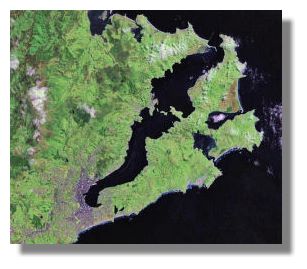
On the other hand, the number of Scottish names equals and in some districts exceeds the number of English names in New Zealand's Otago Province (seen here from NASA's Landsat), and in many parts of Canada and South Africa. Scottish place names are also found in abundance in Greater Pittsburgh, a city that is more closely associated with the English, Irish, Germans, Italians and Poles than with the Scots.
Large cosmopolitan cities such as New York, Los Angeles, Sydney and Johannesburg have many Scottish place names but these vie with names from other cultures and ethnic groups, resulting in a reduced percentage share of the total. Scottish place names tend to be more prevalent in the smaller cities and towns.
Johannesburg has possibly the world's largest cluster of contiguous suburbs with Scottish names outside Scotland, stretching nearly 10 kilometres (6 miles) from Blairgowrie in the west to Highlands North in the east. Similar, but less compact clusters can be found in the north-western suburbs of Baltimore, the northern suburbs of Melbourne, the southern suburbs of Adelaide and parts of Sydney and Metropolitan Washington DC.
There appears to be a small group of cities and large towns where ten per cent or more of the names of their districts, neighbourhoods and suburbs have a definite Scottish origin. The list includes Dunedin, Hamilton, Wellington and possibly Christchurch (New Zealand); Winnipeg, Calgary, Hamilton, Edmonton, Halifax, Regina, Vancouver, Ottawa and possibly London (Canada); Canberra, Townsville, Melbourne, Hobart, Brisbane, Adelaide and Perth (Australia); East London and possibly Port Elizabeth (South Africa); Kingston and Montego Bay (Jamaica); and Pittsburgh (USA). There may be other examples in the smaller American cities as well. Canberra is particularly interesting since the names of its suburbs overwhelmingly honour famous Australians rather than towns and villages and the British Isles. The fact that twenty per cent of the names of Canberra's suburbs are Scottish is a demonstration in itself of the role played by the Scots in exploring and governing Australia and the role played by their descendants in the arts, sport, welfare and politics.
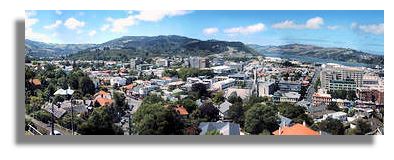 Dunedin in New Zealand (see illustration) is in a league of its own. Founded by the Presbyterian Free Church of Scotland in 1848, the city is proud of its Scots heritage, even down to naming its two main thoroughfares Princes Street and Georges Street, and its main creek Water of Leith, after their namesakes in Edinburgh. In fact, more than 40 per cent of Dunedin's suburbs and streets have Scottish names. Moreover, the countryside surrounding Dunedin is particularly rich in Scottish place names. The small city of Invercargill to the south of Dunedin is of particular interest from a Scottish perspective. Although very few suburbs in Invercargill have Scottish names, nearly all the streets are named for Scottish rivers.
Dunedin in New Zealand (see illustration) is in a league of its own. Founded by the Presbyterian Free Church of Scotland in 1848, the city is proud of its Scots heritage, even down to naming its two main thoroughfares Princes Street and Georges Street, and its main creek Water of Leith, after their namesakes in Edinburgh. In fact, more than 40 per cent of Dunedin's suburbs and streets have Scottish names. Moreover, the countryside surrounding Dunedin is particularly rich in Scottish place names. The small city of Invercargill to the south of Dunedin is of particular interest from a Scottish perspective. Although very few suburbs in Invercargill have Scottish names, nearly all the streets are named for Scottish rivers.
Suburban areas where all or most of the street names are Scottish include Highland Park (Auckland), Corstorphine (Dunedin), Stirling (East London, South Africa), Waverley (Johannesburg), Highlands Park (Gold Coast City, Australia), Macleod (Melbourne) and St Andrews (Campbelltown in Greater Sydney). There are probably many other examples from cities around the world including, as already mentioned, Boston's Aberdeen. In the case of St Andrews, Sydney, not only the streets, but also the parks and reserves all bear Scottish names. This is because of a decision taken in 1976 by the Campbelltown City Council to honour the close links that had been forged between the Council and the Burgh of Campbeltown in Argyll & Bute, Scotland. Campbelltown in Sydney was named in 1820 by Governor Lachlan Macquarie, for the maiden name of his second wife (who came from Argyllshire).
The astonishing number of place names around the world that have direct or indirect connections with Scotland is an enduring legacy of the major contribution made by the Scots and their descendants to the melting pot of cultures that have formed new societies in North America, Africa and the Antipodes.
Explorers and Pioneers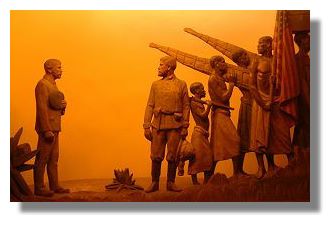
The missionary-explorer David Livingstone is one of the best-known examples in this category. Dr Livingstone's discoveries resulted in place names in the very heart of 'darkest Africa' such as the town of Livingstone in Zambia and the city of Blantyre in Malawi (Blantyre was Livingstone's birthplace in South Lanarkshire). Other Scottish explorers whose names are preserved in local place names include Alexander Mackenzie in Canada and Sir Thomas Livingstone Mitchell in Australia, to name but two.
Scottish missionaries and ministers of religion contributed their share as well. For example, Scotsmen working for the Glasgow Missionary Society in Africa contributed at least three place names in the Ciskei region of South Africa's Eastern Cape Province: Balfour, Lovedale and Pirie while a fourth, Burnshill, was destroyed during the Frontier War of 1851 with Xhosa tribesmen. Another interesting collection of South African place names is to be found in those parts of the Cape Province that had long been colonised by Dutch settlers. The towns of Aberdeen, Alexandria, Fraserburg, McGregor, Murraysburg, Pearston, Robertson and Sutherland all honour Scottish Calvinists who became Dutch Reformed Ministers soon after the Cape became a British possession in 1806.
Pioneers and Other Early Settlers
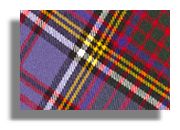 This category forms by far the largest source of Scottish place names abroad. There are thousands of distinctive Scottish family names but the ones that seem to occur most commonly in place names overseas are Anderson (that's their tartan shown here), Bell, Cameron, Campbell, Crawford, Davidson, Douglas, Duncan, Fraser, Gordon, Graham, Grant, Hamilton, Henderson, Irving, MacDonald, MacGregor, Melville, Murray, Paterson, St Clair/Sinclair, Scott, Stewart and Wallace. Many place names featuring Morgan, Lewis, Davis and Jenkins, particularly in the USA, could also have a Scottish or Scots-Irish origin, though these are common Welsh family names which are known to have spread from Pennsylvania to other parts of the USA. The same is true of many common English and Irish family names that turn out to have a Scottish connection.
This category forms by far the largest source of Scottish place names abroad. There are thousands of distinctive Scottish family names but the ones that seem to occur most commonly in place names overseas are Anderson (that's their tartan shown here), Bell, Cameron, Campbell, Crawford, Davidson, Douglas, Duncan, Fraser, Gordon, Graham, Grant, Hamilton, Henderson, Irving, MacDonald, MacGregor, Melville, Murray, Paterson, St Clair/Sinclair, Scott, Stewart and Wallace. Many place names featuring Morgan, Lewis, Davis and Jenkins, particularly in the USA, could also have a Scottish or Scots-Irish origin, though these are common Welsh family names which are known to have spread from Pennsylvania to other parts of the USA. The same is true of many common English and Irish family names that turn out to have a Scottish connection.
A large number of places named for early settlers are prefixed by the word 'Glen', some examples from major cities being Glen Ellen in Baltimore, Glenkay in Johannesburg and Glenferrie in Melbourne. There is an amusing story behind the name "Mac-Mac Falls" in South Africa. These falls were named after the C19th gold-mining village nearby, either for the MacClaughton brothers, said to be the first diggers in the area, or because a list of diggers handed to President T.F. Burgers contained so many Scots names that he called it Mac-Mac.
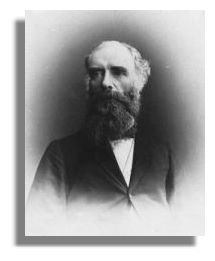 Places named for entrepreneurs form a special sub-category. In Canada, the names of many places honour Forres-born Donald Alexander Smith who, in recognition of his pioneering efforts on behalf of the Hudson's Bay Company and the Canadian Pacific Railway, was created Lord Strathcona (see portrait). Examples include city neighbourhoods called Strathcona in Vancouver, Edmonton and Hamilton, Strathcona Gardens (Burlington), Strathcona Park (Calgary) and Transcona (Winnipeg and Regina). Another Canadian example is Lanark-born James Douglas, the "Father of British Columbia", after whom several places were named including, most probably, the neighbourhood of Douglas in Surrey, Vancouver. In the USA, a well-known example is the township of Carnegie in Metropolitan Pittsburgh whose name honours the Dunfermline-born steel magnate and philanthropist, Andrew Carnegie, while other American places and even a suburb of Melbourne were also named for him.
Places named for entrepreneurs form a special sub-category. In Canada, the names of many places honour Forres-born Donald Alexander Smith who, in recognition of his pioneering efforts on behalf of the Hudson's Bay Company and the Canadian Pacific Railway, was created Lord Strathcona (see portrait). Examples include city neighbourhoods called Strathcona in Vancouver, Edmonton and Hamilton, Strathcona Gardens (Burlington), Strathcona Park (Calgary) and Transcona (Winnipeg and Regina). Another Canadian example is Lanark-born James Douglas, the "Father of British Columbia", after whom several places were named including, most probably, the neighbourhood of Douglas in Surrey, Vancouver. In the USA, a well-known example is the township of Carnegie in Metropolitan Pittsburgh whose name honours the Dunfermline-born steel magnate and philanthropist, Andrew Carnegie, while other American places and even a suburb of Melbourne were also named for him.
Less illustrious businessmen and professionals are honoured in virtually every city in the world. Examples of neighbourhoods named for Scots-born pioneers show just how diverse were the skills taken to the colonies. Balmain, Sydney was named for a First Fleet surgeon; Auldana, Adelaide recalls a publican and wine and spirits merchant; and Campbell, Canberra honours Sydney's first merchant. Two further examples come from the Canadian city of Edmonton: Edmiston Industrial, which was named for the architect who designed Edmonton's first post office, and Rossdale, named after Edmonton's first hotellier. In all of these instances, the people concerned came from Scotland.
Notables - Mayors and Aldermen
There is hardly a city anywhere in the world that has not named at least one of its districts after a mayor or councillor. Scottish examples include Petrie Terrace (John Petrie was Brisbane's first mayor), McCauley (Matthew McCauley was Edmonton's first mayor), Ramsay (Calgary), Lamontville (Durban) and McLeanville (Port Elizabeth).
Notables -Royalty and Nobility
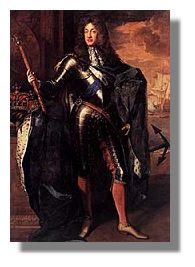
Albany is perhaps the most common example here. This noble Scottish title was first conferred in 1398 upon Robert, brother of Robert III (born John) of Scotland, and is now used by the British royal family. The city of Albany in New York State, was named in honour of the Duke of York and Albany, who later became James VII of Scotland and II of England (illustrated here). Other examples from around the world include Albany Creek (Brisbane), Albany Park (Chicago), New Albany (Columbus, Ohio), the district of Albany in the Eastern Cape Province of South Africa and places simply called Albany in Auckland, San Francisco and Newcastle-upon-Tyne.
Other examples are Strathmore in Melbourne (honouring the late Queen Mother), Melville in Perth (named after Robert Dundas, the second Viscount Melville), Minto in Sydney (Gilbert Elliot Minto, Governor of India from 1807 to 1814), Atholl Heights in Durban (the Duke of Atholl), Buccleuch in Johannesburg (the Duke of Buccleuch) and Perth Amboy in Metropolitan New York (the Earl of Perth).
Notables -Administrators and Politicians
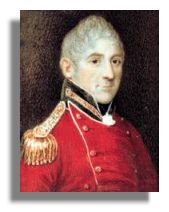 There are many examples of places named for Governors, Governors-General, Premiers and Prime Ministers. Good Canadian examples are the numerous localities named Lorne or Argyll for John Douglas Sutherland Campbell (the Marquess of Lorne and the 9th Duke of Argyll) who was Governor General of Canada between 1878 and 1883 and a son-in-law of Queen Victoria. These include the Edmonton neighbourhood of Argyll, Lorneville in New Brunswick and Lorne Park in Mississauga. The best Australian example is Lachlan Macquarie (pictured here), the "Father of Australia", who was one of the most popular colonial Governors of NSW. Macquarie Harbour, Plains and River in Tasmania, Macquarie River, Lake Macquarie and Port Macquarie in NSW, several suburbs in Sydney, Newcastle and Canberra and at least 45 streets, roads and avenues in Metropolitan Sydney were all named in his honour. Macquarie was an inveterate place-namer, bestowing on the Australian landscape several Scottish names connected with his birthplace in the Hebrides and that of his wife in Argyllshire. Other places honouring Governors or Provincial Superintendents include Maitland (Cape Town) and MacAndrew Bay (Dunedin).
There are many examples of places named for Governors, Governors-General, Premiers and Prime Ministers. Good Canadian examples are the numerous localities named Lorne or Argyll for John Douglas Sutherland Campbell (the Marquess of Lorne and the 9th Duke of Argyll) who was Governor General of Canada between 1878 and 1883 and a son-in-law of Queen Victoria. These include the Edmonton neighbourhood of Argyll, Lorneville in New Brunswick and Lorne Park in Mississauga. The best Australian example is Lachlan Macquarie (pictured here), the "Father of Australia", who was one of the most popular colonial Governors of NSW. Macquarie Harbour, Plains and River in Tasmania, Macquarie River, Lake Macquarie and Port Macquarie in NSW, several suburbs in Sydney, Newcastle and Canberra and at least 45 streets, roads and avenues in Metropolitan Sydney were all named in his honour. Macquarie was an inveterate place-namer, bestowing on the Australian landscape several Scottish names connected with his birthplace in the Hebrides and that of his wife in Argyllshire. Other places honouring Governors or Provincial Superintendents include Maitland (Cape Town) and MacAndrew Bay (Dunedin).
An example of a place named for a Colonial Secretary is Glenelg, Adelaide (for Lord Glenelg). Panmure in both Auckland and East London honour the second Lord Panmure (11th Earl of Dalhousie), born at Brechin Castle in Angus and who was Secretary of State for War during the latter part of the Crimean War. Similarly, the Hamilton (Ontario) neighbourhood of Dundas honours Henry Dundas, 1st Viscount Melville and Baron Dunira. Places named for Governors-General include Novar Gardens (Adelaide) and Gowrie (Canberra). Even Attorneys-General and Surveyors-General get a look in, examples being the Edmonton neighbourhood of Lymburn, named for John F. Lymburn, Attorney General of Alberta and the Cape Town suburb of Bellville, whose name honours Charles Davidson Bell, Surveyor-General of the Cape, artist and designer of the Cape triangular postage stamp.
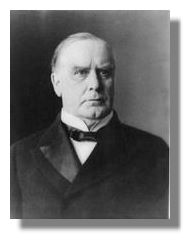 Many American Presidents had Scottish ancestors, resulting in hundreds of towns and villages named after Presidents Andrew Johnson, Chester Alan Arthur, William McKinley (see illustration) and William Howard Taft, not to mention Presidents Ulysses Simpson Grant and James Monroe, where the Scottish connection is more remote. Perhaps the best-known example here is Mount McKinley in Alaska, the tallest mountain in North America.
Many American Presidents had Scottish ancestors, resulting in hundreds of towns and villages named after Presidents Andrew Johnson, Chester Alan Arthur, William McKinley (see illustration) and William Howard Taft, not to mention Presidents Ulysses Simpson Grant and James Monroe, where the Scottish connection is more remote. Perhaps the best-known example here is Mount McKinley in Alaska, the tallest mountain in North America.
Notables -Military Generals
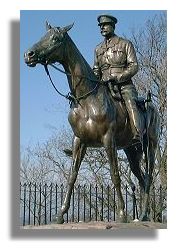 The city of Houston was named for General Sam Houston, who fought for Texan independence from Mexico and who had Scottish ancestors on both sides of his family. Another American example is Major-General Edward Braddock, who was born in Perthshire in about 1695 and whose memory is perpetuated in the name of the town of Braddock near Pittsburgh, and probably other places as well. A more recent example is Edinburgh-born General Douglas Haig, Commander-in-Chief of the British Army in France between 1915 and 1918, after whom several places were named, including a suburb of Brisbane. That's his statue on the esplanade of Edinburgh Castle in the illustration.
The city of Houston was named for General Sam Houston, who fought for Texan independence from Mexico and who had Scottish ancestors on both sides of his family. Another American example is Major-General Edward Braddock, who was born in Perthshire in about 1695 and whose memory is perpetuated in the name of the town of Braddock near Pittsburgh, and probably other places as well. A more recent example is Edinburgh-born General Douglas Haig, Commander-in-Chief of the British Army in France between 1915 and 1918, after whom several places were named, including a suburb of Brisbane. That's his statue on the esplanade of Edinburgh Castle in the illustration.
Scottish Locations
Towns, Villages and Regions
The names of many towns, villages and regions from all over Scotland can be found abroad. The most commonly recurring seem to be Aberdeen, Argyle/Argyll, Balmoral, Bannockburn, Dunbarton/Dumbarton, Edinburgh, Dundee, Elgin, Fife, Glasgow, Glencoe, Glengarry, Glenmore, Highland, Inverness, Kelvin Grove, Kelso, Melrose, Midlothian, Montrose, Morningside, Perth, Rosslyn, St. Andrews, Stirling and Strathmore.
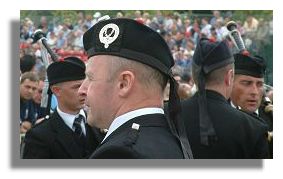 Glengarry is another popularly used name, derived from the distinctive Scottish headgear, the place in Ontario being particularly significant since it was the first Scottish settlement in Upper Canada. Scotland's capital, Edinburgh, proved to be another evergreen and was often corrupted to Edinburg in the USA or Americanised to Edinboro. Some examples include New Edinburgh (the select Ottawa neighbourhood in which the Governor General of Canada's residence is located), Edinboro Estates near Baltimore, and Edinburg Park, a suburban estate near Trenton, New Jersey. Edinburgh is also the name of the capital of the remote South Atlantic island of Tristan da Cunha. The Gaelic form of Edinburgh, Dunedin, has also proved to be fairly popular, examples being the city of Dunedin in New Zealand and places in Florida and Ontario.
Glengarry is another popularly used name, derived from the distinctive Scottish headgear, the place in Ontario being particularly significant since it was the first Scottish settlement in Upper Canada. Scotland's capital, Edinburgh, proved to be another evergreen and was often corrupted to Edinburg in the USA or Americanised to Edinboro. Some examples include New Edinburgh (the select Ottawa neighbourhood in which the Governor General of Canada's residence is located), Edinboro Estates near Baltimore, and Edinburg Park, a suburban estate near Trenton, New Jersey. Edinburgh is also the name of the capital of the remote South Atlantic island of Tristan da Cunha. The Gaelic form of Edinburgh, Dunedin, has also proved to be fairly popular, examples being the city of Dunedin in New Zealand and places in Florida and Ontario.
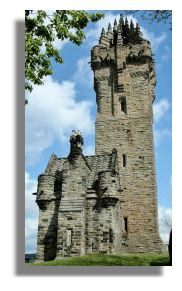 Stirling is another interesting Scottish place name that has travelled around the world. Stirling in Scotland is strongly associated with the Medieval patriot William Wallace, of Battle of Stirling Bridge fame, which is possibly one of the reasons for its popularity abroad. The impressive Wallace National Monument, illustrated here, overlooks the city of Stirling. In addition to it being a suburban name in one American, one South African and three Australian cities, the name is also found in New Zealand and three Canadian provinces. Other examples include Australia's Stirling Creek and Stirling Range while one of the Solomon Islands is called Stirling. Mount Sterling in Kentucky owes its origin to a Scotsman, who named it for his home-town but over the years the spelling changed to Mount Sterling. Sterling occurs very widely throughout the USA and it is tempting to assume that its origin is a misspelling of the original but this might not necessarily be the case given its adjectival meaning of 'being of solid worth'.
Stirling is another interesting Scottish place name that has travelled around the world. Stirling in Scotland is strongly associated with the Medieval patriot William Wallace, of Battle of Stirling Bridge fame, which is possibly one of the reasons for its popularity abroad. The impressive Wallace National Monument, illustrated here, overlooks the city of Stirling. In addition to it being a suburban name in one American, one South African and three Australian cities, the name is also found in New Zealand and three Canadian provinces. Other examples include Australia's Stirling Creek and Stirling Range while one of the Solomon Islands is called Stirling. Mount Sterling in Kentucky owes its origin to a Scotsman, who named it for his home-town but over the years the spelling changed to Mount Sterling. Sterling occurs very widely throughout the USA and it is tempting to assume that its origin is a misspelling of the original but this might not necessarily be the case given its adjectival meaning of 'being of solid worth'.
One of the most iconic of all the Scottish place names, Gretna, is to be found on occasion outside Scotland, including its use as the name of neighbourhoods in Chicago, New Orleans and Omaha. The New Orleans suburb was apparently named Gretna because an early Justice of the Peace carried out marriages around the clock without the need for a legal certificate. The little town of Gretna in Manitoba, Canada was so named by the Canadian Pacific Railroad because it was just over the border from the USA. The early railway companies in fact played a considerable role, not only in Canada, but in Australia and South Africa as well, in choosing Scottish names for their stations and halts. Indeed, one of the quickest ways of picking up Scottish place names in Australia, Canada and South Africa is to trace the course of railway lines on a detailed map.
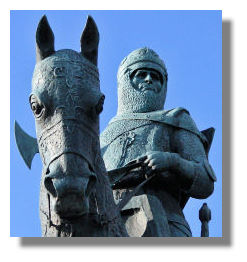 And of course places simply called Scotland or Caledonia can be found all over the world. At least 22 places in the USA have been called Scotland, not to mention city districts and suburbs such as Scotland Island (Sydney), New Scotland (Moncton), Scotlandville (Baton Rouge, Louisiana), Scottish Manor (Atlanta), Scottish Highlands (Nashville), Scottish Hills (Durham, North Carolina) and Scotch Plains (Union, New Jersey). Caledonia, the ancient Roman name for the Scottish Highlands, is similarly commemorated by places in at least 16 American States. Bannockburn (that's King Robert the Bruce's statue at the site of his famous victory over the English king at Bannockburn shown here), Culloden, Glencoe and St Andrews all represent 'patriotic' names, St Andrew, of course, being Scotland's patron saint while the others refer to names that have been etched into the Scottish psyche. It might be thought that Scottish settlers would want to forget Culloden but the name occurs in at least two Canadian provinces and two American states.
And of course places simply called Scotland or Caledonia can be found all over the world. At least 22 places in the USA have been called Scotland, not to mention city districts and suburbs such as Scotland Island (Sydney), New Scotland (Moncton), Scotlandville (Baton Rouge, Louisiana), Scottish Manor (Atlanta), Scottish Highlands (Nashville), Scottish Hills (Durham, North Carolina) and Scotch Plains (Union, New Jersey). Caledonia, the ancient Roman name for the Scottish Highlands, is similarly commemorated by places in at least 16 American States. Bannockburn (that's King Robert the Bruce's statue at the site of his famous victory over the English king at Bannockburn shown here), Culloden, Glencoe and St Andrews all represent 'patriotic' names, St Andrew, of course, being Scotland's patron saint while the others refer to names that have been etched into the Scottish psyche. It might be thought that Scottish settlers would want to forget Culloden but the name occurs in at least two Canadian provinces and two American states.
Mountains, Rivers, Lochs and Islands
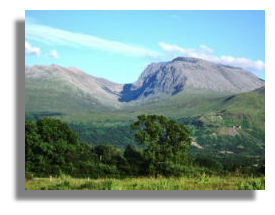 The Witteberge mountain range in South Africa's Eastern Cape has several peaks with Scottish names including Scotland's tallest mountains, Ben Nevis (seen here) and Ben Macdhui, while further to the north-east in the Drakensberg range is Ben Dearg, which apparently resembles the Scottish peak. The Grampians gave their name to a mountain range and national park to the north-west of Melbourne, Australia while Arthur's Seat in Edinburgh can also be found on the Mornington Peninsula south of Melbourne, near Bridgetown in Barbados and in KwaZulu/Natal, South Africa. Surprisingly, the best known of the Scottish islands, Skye, does not appear to have been used as frequently as one would expect, two examples being localities on the fringes of Melbourne and Adelaide. The Orkneys appear to have received greater favour. Examples are a small town in Saskatchewan, a town in Kentucky and a gold mining town in South Africa all called Orkney. Even the remote island of St Kilda seems to have been used as a place name more frequently than the tourist mecca of Skye (in the cities at least, where suburbs called St Kilda can be found in Adelaide, Melbourne, Dunedin and Cape Town).
The Witteberge mountain range in South Africa's Eastern Cape has several peaks with Scottish names including Scotland's tallest mountains, Ben Nevis (seen here) and Ben Macdhui, while further to the north-east in the Drakensberg range is Ben Dearg, which apparently resembles the Scottish peak. The Grampians gave their name to a mountain range and national park to the north-west of Melbourne, Australia while Arthur's Seat in Edinburgh can also be found on the Mornington Peninsula south of Melbourne, near Bridgetown in Barbados and in KwaZulu/Natal, South Africa. Surprisingly, the best known of the Scottish islands, Skye, does not appear to have been used as frequently as one would expect, two examples being localities on the fringes of Melbourne and Adelaide. The Orkneys appear to have received greater favour. Examples are a small town in Saskatchewan, a town in Kentucky and a gold mining town in South Africa all called Orkney. Even the remote island of St Kilda seems to have been used as a place name more frequently than the tourist mecca of Skye (in the cities at least, where suburbs called St Kilda can be found in Adelaide, Melbourne, Dunedin and Cape Town).
The rivers Clyde, Tay, Tweed and Spey appear to have been a rich source of colonial place names, examples being Tay Valley in New Brunswick, Speyside west of Toronto and Tweed Heads on the Gold Coast of Australia. The Clyde has proved to be by the far the best travelled of these names. In the metropolitan areas alone, communities called Clyde can be found in Chicago, Detroit, Melbourne, Greater Newark (New Jersey), Providence (Rhode Island), the San Francisco Bay Area and Seattle. Even the river's ancient Gaelic name, Clutha, is also recalled in one or two place names in New Zealand, Canada and South Africa.

Scotland's most visited loch, Loch Lomond (see picture above), has namesakes in Atlanta (Loch Lomond Estates), Greater Washington DC (West Gate of Lomond) and Toowoomba (Glen Lomond), while the large lake near the airport at Saint John, New Brunswick is actually called Loch Lomond. In Tasmania, there is a national park called Ben Lomond, which was doubtless named after the mountain of that name near Loch Lomond. The community of Loch Arbour in Monmouth County, New Jersey is another example of a place named for a Scottish loch - Lochaber. Rather surprisingly, Scotland's other famous loch, Loch Ness, does not appear to have been remembered by Scottish settlers. There is a small county in Kansas, called Ness, with its county seat at the tiny settlement of Ness City (population 1,534 in 2000 and declining). However, it was named for a soldier in the American Civil War rather than the Scottish loch.
Literary and Other Sources
Literary Sources
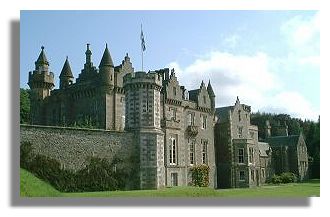 During the nineteenth century, many places were named for popular novels, poems and their authors. Of the Scottish examples, two writers stand out in this regard - the novelist Sir Walter Scott and Scotland's national poet, Robert Burns. A surprisingly large number of places were named for Sir Walter Scott novels and poems, or characters in his novels, the two that occur most frequently being Waverley (Waverly in the USA) and Ivanhoe. Ironically, neither of these names is actually Scottish! Just as popular, it would seem, is Abbotsford, the name of Sir Walter's residence in the Scottish Borders (see illustration), which can be found in Melbourne, Sydney, Dunedin, East London, Johannesburg, Philadelphia and near Vancouver. One is tempted to speculate that the popularity of Melrose around the world has to do with the town's proximity, in Scotland, to Abbotsford. Melrose is found in at least 19 American States and is hugely popular as a suburban name. The suburban list is quite extensive, the name being used in Adelaide, Sydney, London (Ontario), Winnipeg, Wellington, Johannesburg, Baltimore, Boston, Charleston (South Carolina), Chicago, Hartford (Connecticut), Houston, Miami, Mobile (Alabama), New York, Philadelphia and St Louis. There is even a neighbourhood of Austin, Texas called Rob Roy, named no doubt after Rob Roy McGregor, whose cattle rustling lifestyle was romanticised and popularised by Sir Walter. One suspects that some of the many places around the world called Ellerslie, Lochiel, Lochinvar, Midlothian, Montrose, Kenilworth, Ravenswood and Woodstock might also be attributable to Sir Walter Scot novels and characters, though not all of these are Scottish names.
During the nineteenth century, many places were named for popular novels, poems and their authors. Of the Scottish examples, two writers stand out in this regard - the novelist Sir Walter Scott and Scotland's national poet, Robert Burns. A surprisingly large number of places were named for Sir Walter Scott novels and poems, or characters in his novels, the two that occur most frequently being Waverley (Waverly in the USA) and Ivanhoe. Ironically, neither of these names is actually Scottish! Just as popular, it would seem, is Abbotsford, the name of Sir Walter's residence in the Scottish Borders (see illustration), which can be found in Melbourne, Sydney, Dunedin, East London, Johannesburg, Philadelphia and near Vancouver. One is tempted to speculate that the popularity of Melrose around the world has to do with the town's proximity, in Scotland, to Abbotsford. Melrose is found in at least 19 American States and is hugely popular as a suburban name. The suburban list is quite extensive, the name being used in Adelaide, Sydney, London (Ontario), Winnipeg, Wellington, Johannesburg, Baltimore, Boston, Charleston (South Carolina), Chicago, Hartford (Connecticut), Houston, Miami, Mobile (Alabama), New York, Philadelphia and St Louis. There is even a neighbourhood of Austin, Texas called Rob Roy, named no doubt after Rob Roy McGregor, whose cattle rustling lifestyle was romanticised and popularised by Sir Walter. One suspects that some of the many places around the world called Ellerslie, Lochiel, Lochinvar, Midlothian, Montrose, Kenilworth, Ravenswood and Woodstock might also be attributable to Sir Walter Scot novels and characters, though not all of these are Scottish names.
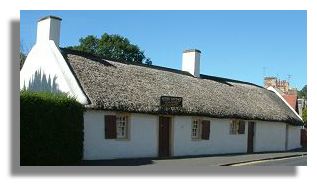
To Robert Burns are attributed place names such as Alloway (that's his birthplace in Alloway shown here), Brigadoon and Tam O' Shanter, while the town of Mosgiel, near Dunedin, New Zealand was named after Robert Burns's farm in Ayrshire, 'Mossgiel'. It is also possible that Ballantrae near Toronto and Ballantrae Farms near Washington DC may have been named for one of Robert Louis Stevenson's novels 'The Master of Ballantrae'.
Other Sources
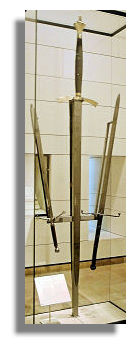 Several places have names that are decidedly Scottish but which do not exist in Scotland itself. This category includes places that use Scottish words, for example, Braeheid Survey in Hamilton (Ontario), Bonnie Glen near Atlanta, Braeburn in Houston, Bonnie Brae near Baltimore and Muckleneuk in Pretoria. Burnside, which does occur frequently as a place name in Scotland, is a name that was often chosen by Scottish settlers who owned land near a creek, 'burn' being the Scots word for a stream. Cities in which Burnside can be found include Adelaide and Melbourne in Australia, Halifax in Canada, Christchurch and Dunedin in New Zealand, Bulawayo in Zimbabwe and Chicago, Columbia (South Carolina), Hartford (Connecticut) and Portland (Oregon) in the USA. There is also a Burnside Valley in Kingston, Jamaica, and Burnside Farms in Richmond, Virginia. One particularly interesting place name is the Greater Sydney suburb of Claymore, which took its name from an estate whose owner had erected three mock claymores (Highlander battle swords) at the gates of his property. The picture on the right shows claymores of various sizes in the Museum of Scotland in Edinburgh.
Several places have names that are decidedly Scottish but which do not exist in Scotland itself. This category includes places that use Scottish words, for example, Braeheid Survey in Hamilton (Ontario), Bonnie Glen near Atlanta, Braeburn in Houston, Bonnie Brae near Baltimore and Muckleneuk in Pretoria. Burnside, which does occur frequently as a place name in Scotland, is a name that was often chosen by Scottish settlers who owned land near a creek, 'burn' being the Scots word for a stream. Cities in which Burnside can be found include Adelaide and Melbourne in Australia, Halifax in Canada, Christchurch and Dunedin in New Zealand, Bulawayo in Zimbabwe and Chicago, Columbia (South Carolina), Hartford (Connecticut) and Portland (Oregon) in the USA. There is also a Burnside Valley in Kingston, Jamaica, and Burnside Farms in Richmond, Virginia. One particularly interesting place name is the Greater Sydney suburb of Claymore, which took its name from an estate whose owner had erected three mock claymores (Highlander battle swords) at the gates of his property. The picture on the right shows claymores of various sizes in the Museum of Scotland in Edinburgh.
Five names keep cropping up with monotonous regularity all over North America and occasionally in other countries as well. North American cities delight in giving their neighbourhoods Scottish-sounding names like Glendale, Highland, Highland Park, Glenwood and Morningside. In most of these instances, the name was probably borrowed from some other city rather than from Scotland itself. Glendale is a particularly intriguing name. There is a village in the Highlands of Scotland called Glendale, which may have been the inspiration for one of the places in North America. However, it is a tautology, made up from a Gaelic word (gleann) and a Norse word (dalr), both of which mean 'valley'. In the USA the name 'Highland' tends to be not only overused but misused, on occasion. For instance, the name 'Highland Heights' occurs as a suburban name in at least five American cities (Cincinnati, Cleveland, Houston, Memphis and Nashville). The superlative 'Upper Highland Heights' has yet to be invented, though the term could well be used by estate agents in the American cities concerned!
As one might expect when cultures meet, as they did in the colonies, there is a large array of hybrid names. Scottish-French examples include Jardines Mackenzie King (Hull) and Plage-Gilmour (Quebec City), while McMillan Mesa in Phoenix, Arizona provides a Scottish-Spanish example. Perth Amboy near New York was named for the Earl of Perth together with a local Native American word 'ompage', meaning 'standing or upright'. South Africa is full of Scottish-Dutch combinations, examples being Bell's Kop (a hill in Mpumalanga), Loch Vaal (a lake on the Vaal River) and Aberdeenvlakte (plains in the Eastern Cape). There is even a Zulu example, the Durban suburb of KwaMashu being a corruption of Kwa Marshall, 'the home of Marshall', named after Sir Marshall Campbell.
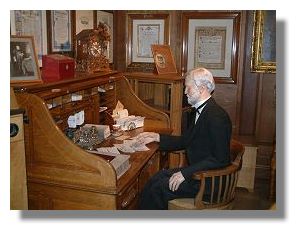 Not all of the Scottish place names in the colonies were direct imports from Scotland. Some took a more circuitous route. For instance, Perth's Thornlie came via Madras in India, Melbourne's Carnegie came from Pittsburgh and Pretoria's Waverley was named for the suburb in Sydney. (The illustration here is of a replica of steel-magnate and philanthropist Andrew Carnegie's office, built in the museum beside his birthplace in Dunfermline). Nor is it true that the stories behind Scottish place names were all happy ones. Grant's Pass in Oregon preserves the memory of a pioneer and his followers who lost their lives during a blizzard. Major-General Edward Braddock, who gave his name to at least one community in Pennsylvania, was mortally wounded in a battle with the French and their Native American allies in 1755. In Brisbane, the suburb of Logan was named for Captain Patrick Logan, whose cruelty toward his charges in the convict settlement of Moreton Bay resulted in his murder under mysterious circumstances. There must be many other tragedies behind the names of places that honour early pioneers and administrators, particularly among the Scots-Irish who opened up the interior of North America to European settlement.
Not all of the Scottish place names in the colonies were direct imports from Scotland. Some took a more circuitous route. For instance, Perth's Thornlie came via Madras in India, Melbourne's Carnegie came from Pittsburgh and Pretoria's Waverley was named for the suburb in Sydney. (The illustration here is of a replica of steel-magnate and philanthropist Andrew Carnegie's office, built in the museum beside his birthplace in Dunfermline). Nor is it true that the stories behind Scottish place names were all happy ones. Grant's Pass in Oregon preserves the memory of a pioneer and his followers who lost their lives during a blizzard. Major-General Edward Braddock, who gave his name to at least one community in Pennsylvania, was mortally wounded in a battle with the French and their Native American allies in 1755. In Brisbane, the suburb of Logan was named for Captain Patrick Logan, whose cruelty toward his charges in the convict settlement of Moreton Bay resulted in his murder under mysterious circumstances. There must be many other tragedies behind the names of places that honour early pioneers and administrators, particularly among the Scots-Irish who opened up the interior of North America to European settlement.
Some Lost and Forgotten Place Names
Chimanimani in Zimbabwe was once called Melsetter and Mbala in Zambia used to be known as Abercorn. An early casualty in South Africa was Roburnia, a Scottish settlement established by Alexander McCorkindale, the name of which was changed in 1882 to Amsterdam, out of gratitude for Dutch sympathy for the Boers during the first Anglo-Boer War. It is likely that further name changes may occur in Africa, particularly in South Africa, where there is a campaign to rid the country of reminders of its colonial past. This clearly poses a threat to several Scottish place names in South Africa. Controversy also surrounds the naming of Mount McKinley, which is regarded as colonial and disrespectful by Native Americans and which is now known officially in Alaska as Denali.
A large number of Scottish names have come and gone without the intervention of post-independence and local minority movements, especially the names of city districts and neighbourhoods. Examples of Scottish place names that no longer exist are Glasgow (a county in North Carolina now called Greene), Caledonia (a suburb of Perth now called Postans) and Braemar Heights (an abolished subdivision of Edmonton). Adelaide in South Australia has lost as many as five Scottish place names over the years: Dunrobin, Elgin, Kirkcaldy, Murray Park and Strathmont.
Some New Place Names
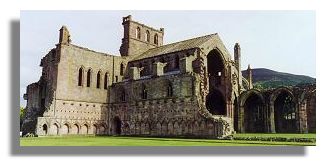 On the other hand, new Scottish names are being coined or adopted all the time, some examples being Melrose Park (Adelaide, 1989) from the Scottish Borders town with its ruined abbey (seen here), Gowanbrae (Melbourne, 1990s) and Inverness (Calgary, early 2000s). Scottish names have sometimes also been gained at the expense of other ethnic groups, particularly the Germans. As a result of anti-German feeling during World War I a large number of German place names were lost in Australia. Two of the many Scottish replacements were Aberfoyle Park in Adelaide and the Greater Brisbane suburb of Haigslea (known previously as Kirchheim, but changed to honour Scots-born General Haig). The Geelong suburb of Bellbrae was named in the mistaken belief that its original name, Jan Juc, was German, but it was actually Aboriginal! In Adelaide, the Welsh lost Swansea when it was renamed Largs North after Largs Bay in Ayrshire while in Perth (Western Australia), the English name of West Guildford became Bassendean in 1922, after a local property that recalled the village in Berwickshire. Some new Scottish names replaced others that were also of Scottish origin. For instance, the city of Brisbane in Queensland, Australia could so easily be known today by its original, briefly held, name 'Edinglassie' (a blend of Edinburgh and Glasgow) but was named, instead, for Scots-born Governor Sir Thomas Makdougall Brisbane.
On the other hand, new Scottish names are being coined or adopted all the time, some examples being Melrose Park (Adelaide, 1989) from the Scottish Borders town with its ruined abbey (seen here), Gowanbrae (Melbourne, 1990s) and Inverness (Calgary, early 2000s). Scottish names have sometimes also been gained at the expense of other ethnic groups, particularly the Germans. As a result of anti-German feeling during World War I a large number of German place names were lost in Australia. Two of the many Scottish replacements were Aberfoyle Park in Adelaide and the Greater Brisbane suburb of Haigslea (known previously as Kirchheim, but changed to honour Scots-born General Haig). The Geelong suburb of Bellbrae was named in the mistaken belief that its original name, Jan Juc, was German, but it was actually Aboriginal! In Adelaide, the Welsh lost Swansea when it was renamed Largs North after Largs Bay in Ayrshire while in Perth (Western Australia), the English name of West Guildford became Bassendean in 1922, after a local property that recalled the village in Berwickshire. Some new Scottish names replaced others that were also of Scottish origin. For instance, the city of Brisbane in Queensland, Australia could so easily be known today by its original, briefly held, name 'Edinglassie' (a blend of Edinburgh and Glasgow) but was named, instead, for Scots-born Governor Sir Thomas Makdougall Brisbane.
Scottish Place Names Closer to Home
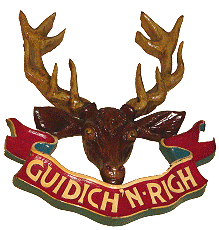 Scottish place names are found in many parts of England and Ireland and there are also one or two in Wales and on the Isle of Man. These names reflect the Scottish diaspora within the British Isles, the result of centuries of steady Scottish migration south of the border or across the North Channel. Some names can be found as far south as Devon, for example Murray's Rock, but the bulk, understandably, are to be found in Northumberland, Cumbria and Yorkshire. Two well-known northern English examples are Scotch Corner in North Yorkshire and Seaforth in Liverpool (named for the residence of the Scottish merchant Sir John Gladstone, the father of Prime Minister W.E. Gladstone). (The ilustration is the crest of the British army regiment, the Seaforth Highlanders. There are many others as well, especially those based on Scottish family names, such as Henderson's House in County Durham, Davidson's Linn in Northumberland and Cowan Bridge in Lancashire.
Scottish place names are found in many parts of England and Ireland and there are also one or two in Wales and on the Isle of Man. These names reflect the Scottish diaspora within the British Isles, the result of centuries of steady Scottish migration south of the border or across the North Channel. Some names can be found as far south as Devon, for example Murray's Rock, but the bulk, understandably, are to be found in Northumberland, Cumbria and Yorkshire. Two well-known northern English examples are Scotch Corner in North Yorkshire and Seaforth in Liverpool (named for the residence of the Scottish merchant Sir John Gladstone, the father of Prime Minister W.E. Gladstone). (The ilustration is the crest of the British army regiment, the Seaforth Highlanders. There are many others as well, especially those based on Scottish family names, such as Henderson's House in County Durham, Davidson's Linn in Northumberland and Cowan Bridge in Lancashire.
The best-known example in Wales is Butetown, a district of Cardiff named for coal mining magnate John Stuart, the Earl of Bute, who settled in Cardiff in 1766, or one of his descendants. Northern Ireland is particularly rich in Scottish place names, for example, Andersonstown, Crawfordsburn, Eglinton, Hamiltonsbawn, McGregor's Corner, Newtownstewart, and many others. In fact, around ten per cent of the names of districts in Greater Belfast appear, on the surface, to be of Scottish origin, including Gaelic names like Glencairn and Dundonald which are not found in other parts of Ireland but which occur in Scotland.
Bibliography
- ACT Government (1992). Canberra's Suburb and Street Names. Canberra: Department of the Environment, Land and Planning.
- City of Edmonton (2004). Naming Edmonton: From Ada to Zoie. Edmonton: The University of Alberta Press.
- Dymock, G. (Compiler) (1994). A.A. Concise Dictionary of New Zealand Place Names. Auckland: Moa Beckett Publishers Ltd.
- Espenshade, A.H. (1995). Pennsylvania Place Names. Baltimore: Geanealogical Publishing Company.
- Humber, D.M. (1994). What's in a Name…Calgary? Volume II. Calgary: Detselig Enterprises Ltd.
- Humber, D.M. (1995). What's in a Name…Calgary?: A Look at the People Behind Place Names in Calgary. Calgary: Detselig Enterprises Ltd.
- Kennedy, B., & Kennedy, B. (1989). Australian Place Names. Sydney: Hodder & Stoughton.
- Kenny, H. (1984). The Place Names of Maryland: Their Origin and Meaning. Baltimore: Maryland Historical Society.
- Praite, R., & Tolley, J.C. (1970). Place Names of South Australia. Adelaide: Rigby Limited.
- Raper, P.E. (1989). Dictionary of Southern African Place Names (Second Edition). Johannesburg: Jonathan Ball Publishers.
- Smith, A.H. (1971). Johannesburg Street Names: A Dictionary of Street, Suburb and Other Place-names, Compiled to the End of 1968. Cape Town: Juta & Company, Limited.
Web Site Links
- ACT Planning and Land Authority, Place Names.
- Geographical Names Board of New South Wales.
- New Jersey Public Library Commission.
- Queensland Government, Department of Natural Resources and Mines, Place Names Online Search.
- South Australian State Gazetteer, Place Names Online.
- Western Australian Government, Department of Land Information.
- Wikipedia (Graphics of Otago Harbour, Dunedin, Lord Strathcona, King James VII, William McKinlay and Ben Nevis were sourced from the relevant pages of Wikipedia).
© Ian Kendall
If you wish to contact Ian about his research, his e-mail address is ian.kendall1@bigpond.com.
Melbourne, Australia, September 2006



